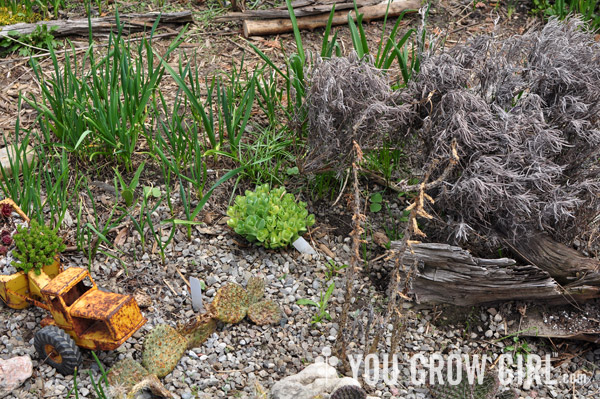
The time has come for me to accept the losses suffered as a result of a peculiarly difficult winter and move on. I’ve known for months that some of these plants were not going to pull through. It is May now, and well past the time when many of them begin to wake up from their winter dormancy. I told myself that the sage and the cholla and the big, ole lavender, and the primulas that never surfaced and all of the other just needed more time. I avoided cutting into them knowing that would prove my wishful thinking wrong.
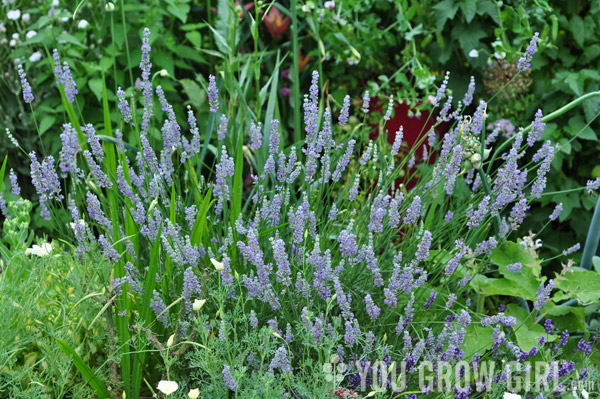
The now dead English Lavender in better times.
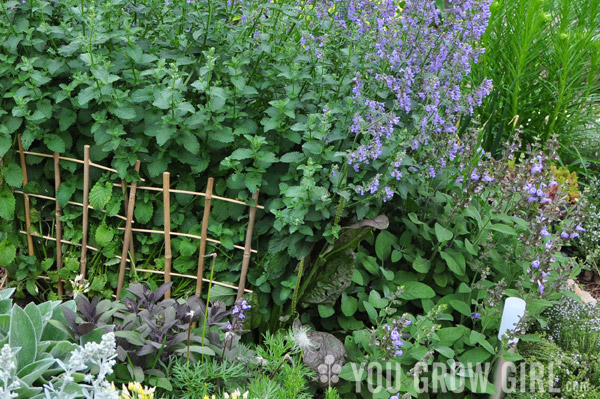
You can just see one of the sages on the right side of the bed.

And here it is today, a sacrifice to the worst winter of my lifetime.
I had formed attachments to many of the plants that were lost — attachments that in some cases I didn’t even know I had. I didn’t know how proud I had been of my beautiful, gnarly ‘Berggarten’ sage plants (there were two), until I was certain that I’d be starting over again this year with puny, unremarkable transplants. I didn’t think I felt one way or the other about the lavender, but when I thought back to how prolifically it had bloomed last summer, I realized that the hydrosol I made last year would be the last. I did know how much I loved the fragrant Citrus Thyme (Thymus x citriodorus)Citrus Thyme (Thymus x citriodorus) that had grown into a small, woody bush and the Sante Fe cholla (Cylindropuntia vindiflora) that had moved with me from the rooftop garden. That plant was just starting to take off in the ground and I had been looking forward to seeing how tall it could grow in this climate. Finding a replacement will be hard.
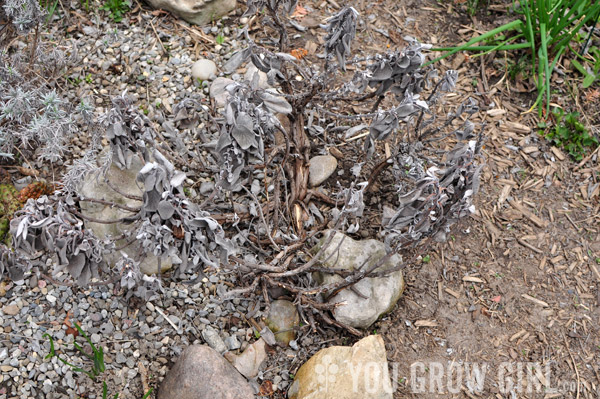
A second ‘Berggarten’ sage that used to live on the edge of the Dry Garden Bed/Rock Garden. Location didn’t mean a thing this year. I had several other small, colourful sages that also bit the dust this winter, although their loss was expected.
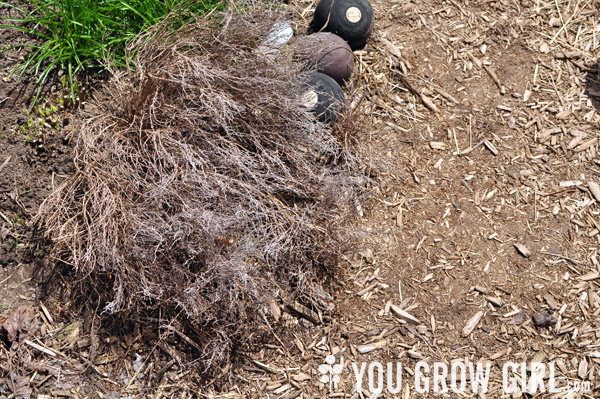
You can see a photo of this Citrus Thyme (Thymus x citriodorus) taken two years ago over here. It had grown even larger and more beautiful and now it is done for.
This is how it is with a garden. Things come and go, and while gardening is often approached as an exercise in control, you learn over and over that you have none. Nature always has the last word. In my case I think this is a useful lesson to learn and one of the many things that I equally despise and appreciate about gardening.
As a plant obsessed person with a garden that is too small to accommodate everything I want, my positive spin on all of this is that it does make room for new plants! Sometimes being forced to let go of our attachments can lead to new experiences that we could not have foreseen. And so, as I prepare to dig out and mourn several dead plants, I have simultaneously begun to ask myself how I will use this unpredicted opportunity.
I feel your pain. We lost a large rosemary bush, 6 Indian hawthornes, and about a dozen assorted perennials. This winter was rough!
I’m so sorry, losing plants sucks. I also feel bad for reassuring you that the cholla would be ok. (I left a comment on your ice storm post … Wow, was that really only this past December? You’re right, this winter was rough.)
If you want, I’d be happy to send you some segments from my chollas here in Santa Fe. (Is that even allowed? Sending plants from the US to Canada?) They’re not Opuntia vindiflora, though. Most likely O. imbricata or O. spinosior. Feel free to email me at the address from the comment form, if you’re interested and think it might work. :)
Don’t feel badly! None of us could have known how crazy this winter would turn out. It wasn’t just the ice storm that did this. I’d love some cuttings but I am not up on current laws about sending even soil-less plant bits over the border. I just avoid it completely. So thank you, but probably best not to.
Maybe you should make this a Grow Write Guild topic? I too have been grieving plants that died and I was taken by surprise at how much it upset me. It may be ridiculous to become attached to a plant, and I didn’t even realize how much I was until now. Gardening tells us so much about ourselves, doesn’t it?
I already have! Not published but I did write one up for the future.
Hi Gayla!
I felt bad complaining about the winter because I’m originally from Ohio and really South Carolina winters are nothing compared to that. But, like you, I’m heart-broken at the loss of a few plants. And even though I know I shouldn’t have expected it to keep growing, I had an orange tree that didn’t make it and my favorite, from seed three year old star fruit tree. This year it might have actually produced something, but now, I’ll never know.
Half of my garlic(!) died. All the softnecks are gone.
I love lavender, it is sad indeed to see it didn’t make it through this harsh winter. You’re right being positive though, and I can’t wait to see what new plants you will bring to your garden!
It’s such a shame that the weather has been so strange last year. I also lost a fair amount of plants during this winter season. But I refuse to give up!
Definitely don’t give up! This was a particularly oddball year.
I completely understand. We can push our zone here with tropicals, but our winter was harsh and those tropicals bit the dust, even a few plants that should have survived, didn’t. What a weird, upsetting winter.
Know exactly what you mean. We had losses on Vancouver Is. (zone 8) this winter too. My 5 ft. Phormium (New Zealand flax) collapsed and it was so hard to hack back the wilted foliage that was so impressive last summer. With any luck it will regrow from the crown. Everything else is filling in like gangbusters though, so there is some consolation.
I’ve been staring at the ground for days, waiting for my irises to poke their little heads up through the ground. They were enormous and gorgeous and yes, I had an emotional attachment. Thanks for this post because now I don’t feel like such a dork for feeling sad.
I also made my rounds, counting my losses. My catnip did not survive, much to my cat’s dismay (he chews on the dead stems anyway). My lemon thyme survived, but my English thyme and creeping thyme, on either side of it, did not. It’s weird because I my flatleaf and curly parsley plants, which normally do not make it, are all coming back up.
I love your site for its content, but I also love that we are in very similar climates and struggle with the same things. RIP, giant lavender that I’ve been growing for past 5 years.
This spring has been so awful with all the plant casualties. I lost a huge old lavender, and some small ones, crocuses didn’t come up, 2 dianthus bit the dust. Even my monarda patch seems to be MIA. Could go on and on.
I haven’t quite managed how to be philosophical about these losses. This winter was a big whomp on the head for us.
We do kind of make friends with our plants, ESP ones we have seen come up year after year, so it’s not surprising we grieve their disappearance. And all we can do is plant more, and hope for some happy surprises later in the season. <-Being philosophical. :^)